Stellar Classification
June 9, 2016
As everyone knows, the
sciences have
traditionally been
male-dominated professions. Worse than that,
scientists and
engineers have a
history of being downright
misogynist. One glaring example of
my generation is the
mnemonic for
electronic component color code. In those days before rapid
printing of fine
pitch numeric characters on odd-shaped objects,
resistance,
capacitance, and
inductance values were specified by bands of
color.
The colors,
black,
brown,
red,
orange,
yellow,
green,
blue,
violet,
gray, and
white, represented the numbers zero-nine. The mnemonic I learned in the dark corner of the
lab was "
Bad boys rape our young girls but violet gives willingly." Violet is still a common name today, ranking 77th as a
girl's name in the current
decade.[1]
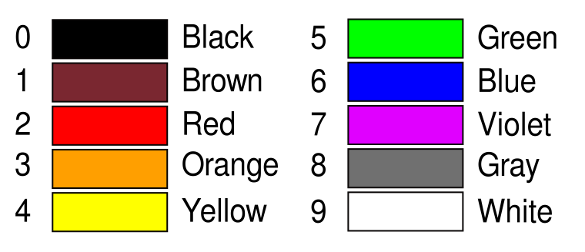
The electronic component color code, used for resistors, capacitors, and inductors. (Created using Inkscape.)
Stars do not have the same
spectral characteristics, since the hotter stars are more blue, and the cooler stars are more red. These different spectral types are identified by a letter code.
Astronomers were somewhat less crude in their mnemonic for
stellar classification.
For historical reasons, the spectral star types were designated,
O,
B,
A,
F,
G,
K,
M. Our
Sun is a type G star; more specifically G2V. The astronomer's mnemonic for the stellar classification is, "Oh, be a fine girl, kiss me!" The one that I learned had three additional spectral types,
R, N,
S at the end, so the mnemonic I learned was "Oh, be a fine girl, kiss me right now, smack!"
Despite the fact that women were not really welcomed in the sciences, there have been quite a few prominent female astronomers, the earliest example being
Caroline Herschel, the sister of the
astronomer, William Herschel. I wrote about Caroline Herschel in an earlier article (Sexism in Science, September 28, 2012).
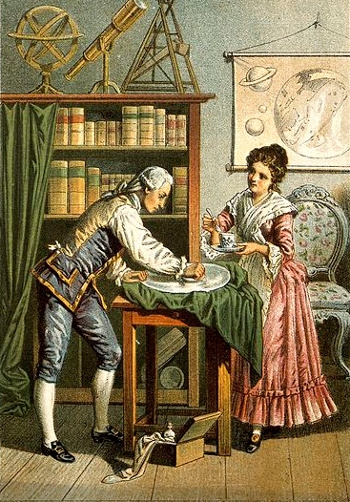
William Herschel, discoverer of the planet, Uranus, and his sister, Caroline.
Herschel is shown polishing a telescope mirror, assisted by Caroline.
Caroline Herschel was awarded a gold medal from the Royal Astronomical Society, and she received a small salary from King George III.
An 1896 lithograph from the Wellcome Library, via Wikimedia Commons.)
While
Edwin Hubble is credited with discovering the
expanding universe that's been a fundamental topic of modern astronomical observations, it was a discovery by
American astronomer,
Henrietta Swan Leavitt (1868-1921) that allowed Hubble's
conjecture. Leavitt discovered the
proportionality between the
period and
luminosity of the
Cepheid variable stars.
These stars are named after the
star,
Delta Cephei, discovered to have variable luminosity in 1784. As Leavitt and her
employer/
colleague,
Edward C. Pickering,
wrote in volume 173 of the
Harvard College Observatory Circular,
"A straight line can readily be drawn among each of the two series of points corresponding to the maxima and minima, thus showing that there is a simple relation between the brightness of the variables and their periods... Since the variables are probably at nearly the same distance from the Earth, their periods are apparently associated with their actual emission of light..."
Leavitt graduated from
Radcliffe College, Harvard's female outpost, in 1893, and she joined the
Harvard College Observatory. Her title there was "computer," and her work was to translate the images of stars on
photographic plates to useful
data. That's how her Cepheid variable discovery was enabled, a discovery that allowed Hubble to relate
galactic redshift to their distance from the Earth, a relationship now known as
Hubble's law.
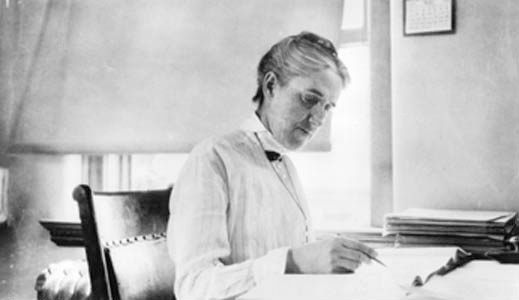
"A woman's work is never done." American astronomer, Henrietta Swan Leavitt (1868-1921). (Photograph from the Emilio Segrè Visual Archives of the American Institute of Physics, via Wikimedia Commons.)
Joining Leavitt as a member of the Harvard College Observatory computers in 1896 was
Annie Jump Cannon (1863-1941), who had received a
physics degree from
Wellesley College in 1884. She had been encouraged in her
scientific studies by her
mother, and she became a Wellesley College student of
Sarah Frances Whiting (1847-1927), one of the earliest woman
physicists in the
United States. Cannon was the
valedictorian of her class at Wellesley College.
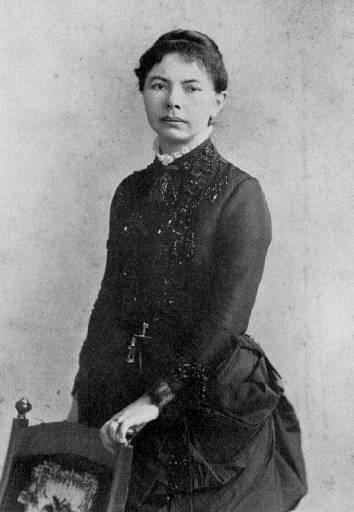
A circa 1879 photograph of Sarah Frances Whiting (1847-1927).
When Wilhelm Röntgen discovered X-rays in 1895, Whiting configured an old Crookes tube to take some of the first radiographs. These were of coins in a purse, and bones through flesh.[3]
(A Wellesley College photograph, via Wikimedia Commons.)
After
graduation, Cannon learned
photography, but she didn't seek any professional position until her mother died in 1894. That year, Whiting hired her as a junior physics teacher at Wellesley. While teaching, Cannon learned
spectroscopy, and she started studies for an
MA degree that was finally completed in 1907. In 1896, physicist and astronomer,
Edward C. Pickering, hired her as his assistant at the Harvard College Observatory.
Cannon's assigned task at Harvard was to catalog variable stars and classify the spectra of stars in the
southern celestial hemisphere.[2] In 1911, her position was advanced to
curator of observational photographs, and she embarked on a forty year project to spectrally classify stars down to
ninth magnitude.[2]
The result of this study was the nine
volumes of the
Henry Draper Catalogue, named after an
amateur astronomer in whose memory the project was funded.[2] This catalog, published from 1918-1924, lists nearly a quarter of a million stars, assigning them to the O, B, A, F, G, K and M letter classification. The catalog was extended over the years, classifying many more stars.
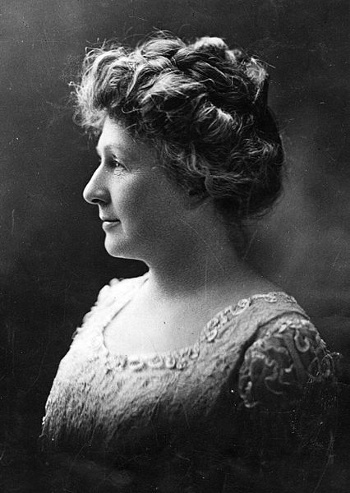
A 1922 portrait of Annie Jump Cannon (1863-1941).
(Portrait appearing in the New York World-Telegram and the Sun Newspaper, via Wikimedia Commons.)
People with
disabilities have made important contributions to science. We have the example of
Stephen Hawking. Annie Cannon was doubly disabled, being nearly
deaf, and also (for that time) a woman. Her deafness is presumed to have been caused by her contracting
scarlet fever. It wasn't until 1938, many years after the Draper Catalogue, that she was promoted from astronomical assistant to astronomer, at age 74.[2]
Aside from classifying stars, Cannon discovered 300 variable stars and five
novas. Her system of stellar classification, with a few additional members (my R, N, and S stars) and other tweaks is still used by today's astronomers. Canon was the first woman officer of the
American Astronomical Society. The
Annie Jump Cannon Award is given annually to a distinguished
North American woman astronomer.
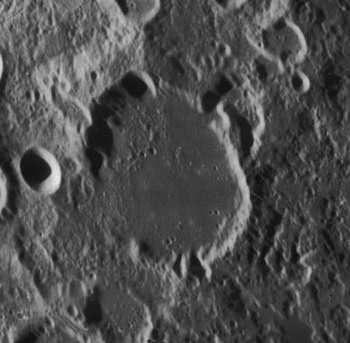
The 56 kilometer diameter Cannon Crater, named after Annie Jump Cannon, is located on the Moon at 19.9°N 81.4°E.
(A Lunar Orbiter 4 image, via Wikimedia Commons.)
![]()
References:
- Baby Names for the 2010 Decade, United States Social Security Administration Web Site.
- Dan Malerbo, "Let's talk about science: development of star classification," Pittsburgh Post-Gazette, May 19, 2016.
- Annie J. Cannon, "Sarah Frances Whiting," Science, vol. 66, no. 1714 (November 4, 1927), pp. 417-418, DOI: 10.1126/science.66.1714.417.
Permanent Link to this article
Linked Keywords: Science; tradition; traditional; male-dominated; profession; scientist; engineer; history; misogyny; misogynist; baby boomer; my generation; mnemonic; electronic component color code; printing; pitch; numeric character; resistance; capacitance; inductance; color; black; brown; red; orange; yellow; green; blue; violet; grey; gray; white; laboratory; lab; Bad boys rape our young girls but violet gives willingly; girl; decade; resistor; capacitor; inductor; Inkscape; star; spectrum; spectral; astronomer; stellar classification; O-type star; B-type main-sequence star; A-type main-sequence star; F-type main-sequence star; G-type main-sequence star; K-type main-sequence star; stellar classification M; Sun; carbon star R, N; S-type star; Caroline Herschel; sibling; sister; astronomer; William Herschel; planet; Uranus; polish; reflecting telescope mirror; Gold Medal of the Royal Astronomical Society; Royal Astronomical Society; salary; George III of the United Kingdom; King George III; lithograph; Wellcome Library; Wikimedia Commons; Edwin Hubble; metric expansion of space; expanding universe; American; Henrietta Swan Leavitt (1868-1921); conjecture; proportionality; period; luminosity; Cepheid variable star; star; Delta Cephei; employer; colleague; Edward C. Pickering; Periods of 25 Variable Stars in the Small Magellanic Cloud; Harvard College Observatory Circular; straight line; point; maxima and minima; Earth; emission of light; Radcliffe College; Harvard College Observatory; photographic plate; data; galactic redshift; Hubble's law; A woman's work is never done; American Institute of Physics; Annie Jump Cannon (1863-1941); physics; academic degree; Wellesley College; scientific; mother; Sarah Frances Whiting (1847-1927); physicist; United States; valedictorian; Wilhelm Röntgen; X-rays; Crookes tube; radiography; radiograph; coin; handbag; purse; bone; flesh; graduation; photography; spectroscopy; Master of Arts; MA degree; southern celestial hemisphere; curator; ninth magnitude; volume; Henry Draper Catalogue; amateur astronomy; amateur astronomer; New York World-Telegram and the Sun Newspaper; disability; Stephen Hawking; hearing loss; deaf; scarlet fever; nova; American Astronomical Society; Annie Jump Cannon Award; North America; Cannon Crater; Moon; Lunar Orbiter 4.